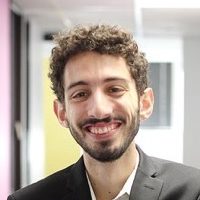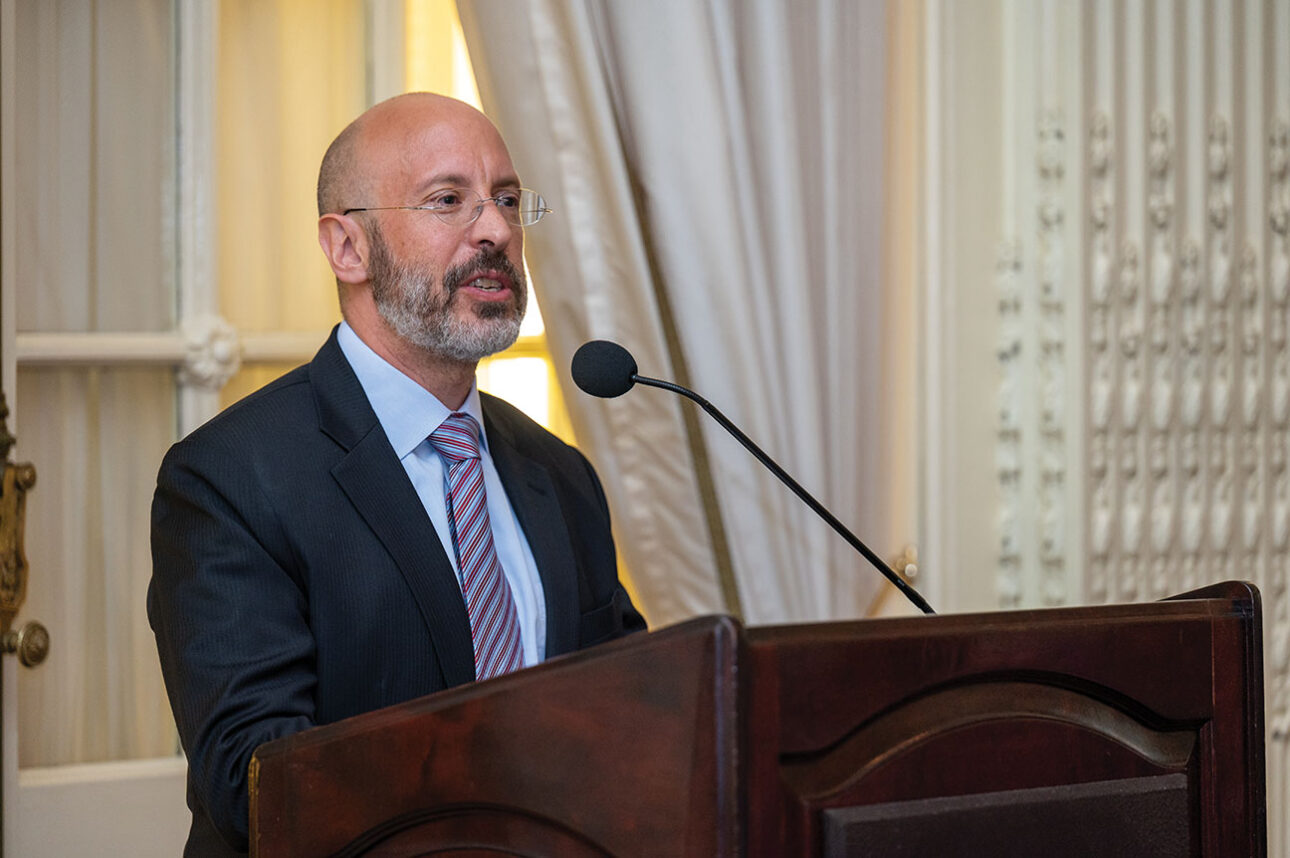In a way, their relationship began like so many others: a workplace romance.
Gabriella Karin, 85, was a docent at the Los Angeles Museum of the Holocaust (LAMOTH); Robert Geminder, 80, who goes by Bob, was on the museum’s board of directors.
His wife, Judy, died four years ago. Her husband, Ofer, passed away two years later. Neither one expected to love romantically again, but both seemed to understand that their long and fruitful marriages marked them as romantics.
“Is the pope Catholic?” Bob said. “I didn’t stay married for 52 years and she didn’t stay married for 64 years for no reason.”
Both are Holocaust survivors, deeply committed these days to a post-retirement career transmitting their stories to young people.
“We were trying to make menschin [upright citizens] out of young people,” he told the Jewish Journal. “We spoke in schools all the time — I did, Gabriella did — way before we even knew we existed.”
On Feb. 17, they’ll celebrate their first anniversary as a couple, on a speaking tour in Baltimore.
It started innocently. The two have known about each other for half a decade. They got to know each other a little better on the March of the Living, the annual youth pilgrimage to Poland and Israel, listening to the other’s stories of surviving the war.
(Both of their life stories have been recorded by Jane Ulman in the Journal’s Survivor series and can be read in full at jewishjournal.com/survivor.)
Soon, they began to notice each other at LAMOTH events they both attended.
“He asked me to save a place next to me when we went to some meeting, so I saved a place,” Gabriella explained. “Next time, he saved a place.”
Then came the act of fate.
At the 2014 annual LAMOTH Chanukah party, E. Randol Schoenberg, then the chair of the museum’s board, persuaded Gabriella to buy a raffle ticket. Sure enough, she won: two tickets to an opera at the Dorothy Chandler Pavilion in downtown Los Angeles.
“I sit down with the ticket, and I ask him, ‘You want to go with me?’ ” she said. “He said, ‘Let me see.’ So he looks in his phone. ‘Yeah, I have time this day. Good!’ So he says, ‘OK, you have tickets, I’m taking you out to dinner.’ ”
The dinner at Bottega Louie on Grand Avenue was the first in a series of dinner dates leading up to Feb. 17, the day of their first kiss.
Since then, they’ve been visiting each other a couple of times a week or on the weekends. Mostly, he drives to her place from his home in Palos Verdes — where he walks his dog past the golf course he says is too expensive to play on but nice to look at.
She lives in the Fairfax neighborhood, close to LAMOTH’s home in Pan Pacific Park on Beverly Boulevard. They have no plans to move in together, instead cherishing the space and time they each need for their busy lives: “It’s great this way,” she said.
Last year, they traveled as a couple to Poland and Israel with the March of the Living youth trip, and they are going back in May for this year’s pilgrimage. They intend to go a week early, so each can tour the areas where the other rode out World War II.
Over a recent Saturday lunch, each waited patiently while the other dutifully shared stories of the Holocaust. Each has done this umpteen times.
Bob clammed up and stared fixedly at his lap while Gabriella told her story. She recounted in soft, accented English how she hid first in a convent and then in a one-bedroom apartment in Slovakia with her mother, father, aunt, two uncles and two family friends — across the street from the regional Gestapo headquarters, miraculously escaping notice.
While the Nazis and their collaborators thinned the ranks of Bratislava’s Jews, Gabriella watched her mother commit acts of daring for the Slovakian underground, accompanying her to warn Jewish families when their names appeared on deportation lists.
Bob cautions against drawing parallels between survivor stories, saying that each is unique.
But he also played eyewitness to his mother’s intuition and courage that mark her as the hero of his story. She sneaked him out of the ghetto on the way to work by hiding him under her skirt, while his brother scampered underneath her girlfriend’s skirt.
“Nobody saw that there were a couple of extra feet under the skirts,” he said.
Another parallel emerges: In both stories, a young couple proves a pivotal agent of survival.
The cramped one-bedroom apartment where Gabriella quietly hid for nine months belonged to her aunt’s boyfriend, Karol Blanar, a young lawyer whom she later successfully nominated to receive Yad Vashem’s Righteous Among the Nations award. Blanar brought food for the family and books for Gabriella to read so she wouldn’t fall behind in her education.
For Bob, it was a man who his widowed mother met in the ghetto who proved integral to arranging a place to stay in occupied Warsaw. Emil Brotfeld would later become Bob’s stepfather when he married Bob’s mother at a displaced persons camp in West Germany after the war.
Neither Bob nor Gabriella put much stock in the idea of fate, or in things turning out as they were somehow meant to.
Bob prefers instead to refer to luck: It was luck, he says, that resulted in his being at the back of the crowd at the Jewish cemetery in Stanislawow (now Ivano-Frankivsk, Ukraine) during the Nazi mass murder of Oct. 12, 1941. If he had been in the front, he might have been among the 14,000 who were assassinated, rather than the 6,000 who lived.
“We were in the first trucks — who knows why?” he said. “It’s not that we were smart to get on the first few trucks — we were pushed on.”
Bob is the talkative one of the two. Gabriella chimes in intermittently to add a detail or to gently correct him, and he treats her graciously.
“I never want to take more time than Gabriella,” he said. “When we speak together, she always gets the extra two minutes.”
“He’s just polite,” she said.
Bob has a curious habit of interspersing his survivor story with jokes. Describing how he scavenged raw eggs to survive while stowed away at a farm near Krakow, he pointed to his full head of hair that, despite his age, has not thinned out.
“Usually at this point I try to find a guy in the audience who’s bald-headed and say ‘See? Raw eggs,’” he said.
He doesn’t joke around to make light of his story, but rather to make it easier for his listeners to stay tuned in.
“It’s such a tense, terrible story for both of us,” he said, before launching back into the recollection. “Not that I want to add humor — I just want to add relief, so people can breathe and listen again.”
If he’s the funny one, she’s the creative one.
Gabriella had a career as a fashion designer before turning to sculpture and illustration, focusing her artwork on themes related to the Holocaust. (Her work can be found at gabriellakarin.com.) She dressed for lunch in a gossamer blue blouse with matching pants and a necklace of her own making.
The two are not affectionate in public, but Bob seems to enjoy doting on her. When somebody set down a bowl of strawberries in front of the two, he turned to Gabriella.
“You don’t want any of these, I know,” he said.
“I’m allergic to strawberries,” she explained.
Later, he tried to pick the marzipan truffle from a box of chocolates to share with Gabriella but picked the caramel one instead.
“That’s not marzipan, Gabriella, I’m sorry,” he said. “We’ll put this one back. I didn’t eat it.”
On the second try, he successfully picked the sweet and split it with her.
Gabriella and Bob don’t exactly buy into the idea of a soul mate. But others who know them aren’t so skeptical.
Samara Hutman, executive director of LAMOTH, waxes poetic when talking about the new couple. She played a key role in their introduction.
“My mother always taught me there’s a lid for every pot,” she told the Journal. “They’re just the perfect lid for each other’s pot — just a perfect fit.”
She admits to getting a little warm and fuzzy about Gabriella and Bob’s relationship. For her, it speaks to the possibility of a second chance at love. But on a personal level, she’s proud of the museum’s role in bringing them together.
“Every time I see them together, my heart smiles like I’m an old lady, like they’re my kids,” she said.
In fact, Hutman was the architect of the raffle that first brought them together for dinner. (“Everything’s better with a raffle,” she said.)
She had known Gabriella for years, because Gabriella got involved with Hutman’s Righteous Conversations project, now under the LAMOTH umbrella, which brings together young people and survivors.
She remembers watching Gabriella care for her late husband when he took ill, after he had for years enthusiastically supported her work as a survivor-storyteller.
“He was as excited about her second career as she was, and when I would go there to visit, he would always give me a flower and a smile,” Hutman recalled. “He was just one of the sweetest people I’ve ever known; their relationship was just so beautiful.”
Hutman hadn’t known Bob all that well until he offered to drive her to the airport on her way to Jerusalem for work.
During that car ride, he unburdened himself to her about how his five-decade marriage had left him a student of loving devotion toward “a really special person,” and to keep her eye out in case she might come across such a person.
“He was kind of putting his soul out to the universe, to me on this drive,” she said.
Hutman is careful not to take too much credit for the relationship. But she said LAMOTH provides a loving community built around Holocaust education that contributed to their meeting. She wouldn’t say if she’s heard of other couples that have met through the museum.
“Are you asking if we’re running a dating service at LAMOTH?” she joked. “I’m not at liberty to say.”
Bob and Gabriella emphasize it was their shared mission of education, of teaching kids about resilience and respect for their fellow humans, that first bound them to each other.
A retired electrical engineer, Bob earned his teaching credential at the age of 70 and now teaches math as a substitute in the Los Angeles Unified School District. He recalled a moment when a student in his math class at a southeast L.A. high school told him he’d heard Bob’s story before in another classroom.
“He’s sitting in class, and he shows me a picture of he and I two years ago,” Bob said. “Do you think he’s going to remember algebra?”
When the lunch wound down, Bob stepped outside and escorted Gabriella to his car, a silver 2016 Corvette Stingray with the dealer plates still on.
“A present to myself for my 80th birthday,” he said.
Bob held the door as Gabriella slid into the passenger seat of the two-door convertible. They waved and then, with a roar of the engine, tore off under a cloudless Los Angeles sky.























 More news and opinions than at a Shabbat dinner, right in your inbox.
More news and opinions than at a Shabbat dinner, right in your inbox.